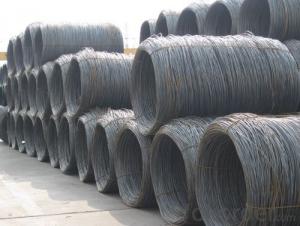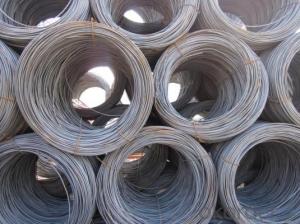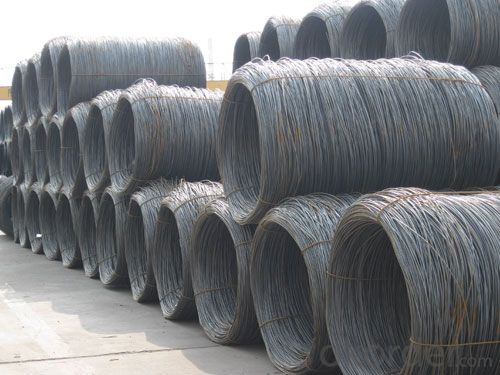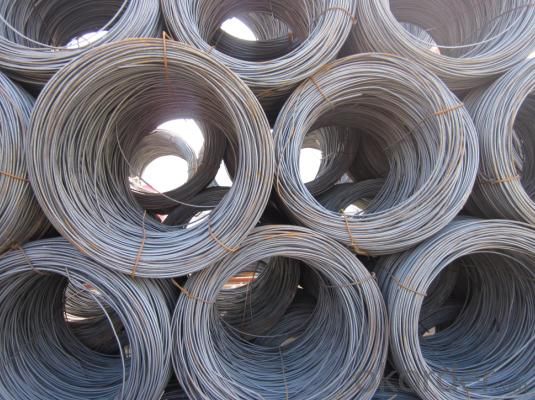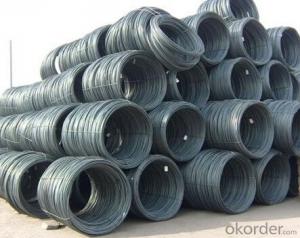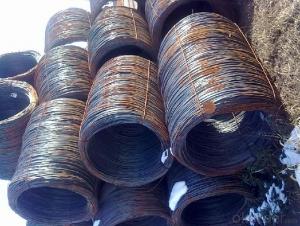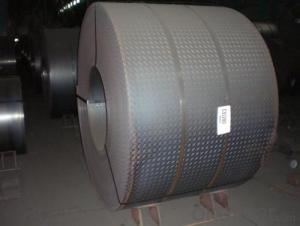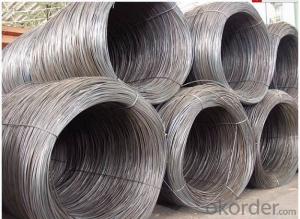High Quality Steel Wire Rod SAE1008 7mm/9mm/11mm
- Loading Port:
- Tianjin
- Payment Terms:
- TT or LC
- Min Order Qty:
- 50 m.t
- Supply Capability:
- 10000 m.t/month
OKorder Service Pledge
OKorder Financial Service
You Might Also Like
High Quality Steel Wire Rod SAE1008 7mm/9mm/11mm
Product Description:
Specifications of Wire Rod SAE1008:
Grade: SAE1008 Standard: ASTM
Diameter: 7mm/9mm/11mm
Alloy or Not: Alloy
Technique: Hot Rolled Place of Origin: China Mainland
Chemical Composition:
Please kindly find our chemistry of our material based on SAE1008 as below for your reference:
Grade | Chemical Composition (%) | |||||
C | Mn | S | P | Si | ||
SAE1008 | 0.10max | 0.32max | 0.045max | 0.040max | 0.30max | |
Mechanical properties | ||||||
Yield strength(N/mm2) | Tensile strength(N/mm2) | Elongation (%) | ||||
≥195 | 350-380 | ≥32 | ||||
Usage and Applications of High Quality Steel Wire Rod SAE1008 7mm/9mm/11mm:
After hot-rolled the products shaped into coil and delivery as finished product, including round, square,rectangular, hexagonal and so on. Since most of the products are round, it is generally called wire rod. Carbon steel wire rod is widely used in construction and manufacturing. Carbon steel wire rod is mainly used for reinforcement of reinforced concrete and welded structure or reprocessed (roberts , nail, etc.) materials, especially used to produce wire drawing, welding electrode, nails, spring, electronic, precise machinery parts and so on.
Packaging & Delivery of High Quality Steel Wire Rod SAE1008 7mm/9mm/11mm:
Packaging Detail: products are packed in coil and then shipped by container or bulk vessel
Each coil weight: About 2.05MT
Delivery Detail: within 45 days after received deposit or LC.
Label: to be specified by customer, generally, each bundle has 1-2 labels
Trade terms: FOB, CFR, CIF
FAQ:
Q1: Why buy Materials & Equipment from OKorder.com?
A1: All products offered byOKorder.com are carefully selected from China's most reliable manufacturing enterprises. Through its ISO certifications, OKorder.com adheres to the highest standards and a commitment to supply chain safety and customer satisfaction.
Q2: How do we guarantee the quality of our products?
A2: We have established an advanced quality management system which conducts strict quality tests at every step, from raw materials to the final product. At the same time, we provide extensive follow-up service assurances as required.
Q3: How soon can we receive the product after purchase?
A3: Within three days of placing an order, we will arrange production. The shipping date is dependent upon the quatity, how many sizes you want and the plan of production, but is typically 1 month to 2 month days from the beginning of production.
Images of High Quality Steel Wire Rod SAE1008 7mm/9mm/11mm:


*If you would like to get our price, please inform us the size, standard/material and quantity. Thank you very much for your attention.
- Q: What are the dimensions and sizes available for steel wire rod?
- The dimensions and sizes available for steel wire rod vary depending on the specific requirements and intended applications. However, common sizes range from 5.5mm to 16mm in diameter. The standard length of steel wire rods is typically around 2-2.5 meters, but longer lengths can also be produced upon request.
- Q: What are the common industry guidelines for steel wire rod professionals?
- The common industry guidelines for steel wire rod professionals include adhering to strict quality control measures, ensuring compliance with safety regulations, maintaining proper handling and storage practices, conducting regular inspections and tests, and keeping up with technological advancements in wire rod production and processing. Additionally, professionals are expected to prioritize customer satisfaction, foster strong communication and collaboration within the industry, and stay updated on market trends and industry standards.
- Q: How is steel wire rod used in the manufacturing of wire for springs in mattresses?
- Steel wire rod is used in the manufacturing of wire for springs in mattresses as it serves as the primary material for creating the springs. The wire rod is first drawn and stretched to the desired thickness and then coiled into springs of various sizes and shapes. These springs are then interconnected to form the core structure of the mattress, providing support and resilience. The high tensile strength and durability of steel wire rod make it an ideal choice for ensuring the longevity and comfort of the mattress.
- Q: How is the steel wire rod market expected to grow in the future?
- The steel wire rod market is expected to grow significantly in the future due to several key factors. Firstly, the increasing demand for steel wire rods in various industries such as construction, automotive, and manufacturing is expected to drive market growth. Steel wire rods are essential for applications such as reinforcement in concrete structures, wire mesh for fencing, and manufacturing of automobile parts. Additionally, the rising urbanization and industrialization in developing economies are likely to fuel the demand for steel wire rods. As these countries continue to invest in infrastructure development and construction projects, the need for steel wire rods will grow substantially. Moreover, the automotive industry's shift towards electric vehicles and lightweight materials is expected to further boost the demand for steel wire rods as they are crucial for producing lightweight yet strong components. Furthermore, advancements in technology and innovation in steel manufacturing processes are anticipated to positively impact the market growth. These advancements allow for the production of high-quality steel wire rods that meet the specific requirements of various industries. Additionally, the implementation of stringent safety and quality standards by regulatory bodies is expected to drive the demand for premium-grade steel wire rods. Moreover, the growing focus on sustainable and eco-friendly construction practices is likely to contribute to market growth. Steel wire rods are recyclable, making them a preferred choice in environmentally conscious projects. Furthermore, the increasing adoption of steel wire rods in the renewable energy sector, particularly wind energy, is expected to create new growth opportunities for the market. In conclusion, the steel wire rod market is expected to witness significant growth in the future, driven by increasing demand from various industries, urbanization, technological advancements, and the focus on sustainable practices.
- Q: How is steel wire rod used in the production of wire mesh for filtration?
- Steel wire rod is an essential component in the production of wire mesh for filtration. It serves as the raw material for manufacturing wire mesh, which is widely used in various industries such as mining, construction, and agriculture. To produce wire mesh for filtration, the steel wire rod goes through a series of manufacturing processes. First, the wire rod is heated and then rolled into thin strands, known as wire. These wires are typically of a consistent diameter and have a smooth surface to ensure high-quality filtration. Next, the wire is woven or welded to create the desired mesh pattern. The weaving process involves interlacing the wires over and under each other, forming a stable and durable mesh structure. Alternatively, the wires can be welded at their intersections to create a more rigid mesh. The steel wire rod used in the production of wire mesh for filtration is chosen for its specific properties. Steel is known for its strength, durability, and corrosion resistance, making it suitable for demanding filtration applications. Additionally, the wire rod can be further treated to enhance its performance, such as by applying coatings to improve resistance to abrasion or chemicals. Once the wire mesh is manufactured, it is used in various filtration applications. Wire mesh filters are commonly used to separate solids from liquids or gases, removing impurities and contaminants. They are also utilized as sieves or screens to classify or separate materials based on their size or shape. In summary, steel wire rod is a crucial material in the production of wire mesh for filtration. It undergoes several manufacturing processes to create the wire mesh, which is then used in diverse filtration applications across different industries. The strength, durability, and corrosion resistance of steel make it an ideal choice for demanding filtration requirements.
- Q: What are the advantages of using steel wire rod in construction?
- There are several advantages of using steel wire rod in construction. Firstly, steel wire rod is known for its high strength and durability, making it ideal for supporting heavy loads and withstanding extreme weather conditions. This ensures the longevity and safety of the construction project. Additionally, steel wire rod is highly flexible and can be easily shaped and bent to fit various construction needs, allowing for versatile and efficient design possibilities. Moreover, steel wire rod is resistant to corrosion, which reduces maintenance costs and increases the lifespan of the construction. Lastly, steel wire rod is a sustainable and recyclable material, making it an environmentally-friendly choice for construction projects.
- Q: What are the different types of wire mesh for sieving made from steel wire rod?
- There are several different types of wire mesh for sieving that are made from steel wire rod. These types include: 1. Plain weave wire mesh: This is the most common type of wire mesh used for sieving. It is made by weaving the steel wire rods together in an over-and-under pattern, creating a square or rectangular mesh structure. Plain weave wire mesh is known for its simplicity and versatility. 2. Twill weave wire mesh: Twill weave wire mesh is similar to plain weave, but the wires are interlaced in a diagonal pattern, creating a tighter mesh structure. This type of wire mesh is often used for fine sieving applications where a higher level of precision is required. 3. Dutch weave wire mesh: Dutch weave wire mesh is made by weaving the wires in an over-and-under pattern, but with different wire diameters for the warp and weft wires. This creates a mesh with smaller openings in one direction, making it ideal for applications where fine particles need to be separated. 4. Welded wire mesh: Welded wire mesh is made by welding the intersecting points of the steel wires together, creating a strong and durable mesh structure. This type of wire mesh is commonly used for heavy-duty sieving applications, such as in construction or industrial settings. 5. Expanded metal mesh: Expanded metal mesh is made by cutting and stretching a flat sheet of steel, creating a mesh with diamond-shaped openings. This type of wire mesh is known for its strength and rigidity, making it suitable for sieving applications that require high impact resistance. Overall, the different types of wire mesh for sieving made from steel wire rod offer a range of options to suit various sieving needs, from basic to more specialized applications. The choice of wire mesh will depend on factors such as the size of the particles being sieved, the desired level of precision, and the intended use of the sieved material.
- Q: How is steel wire rod used in the production of wire ropes for cranes?
- Steel wire rod is a crucial component in the production of wire ropes for cranes. It serves as the raw material that is carefully shaped and formed into strands, which are then twisted and braided together to create the strong and durable wire ropes. The high tensile strength and resilience of the steel wire rod ensure that the wire ropes can withstand heavy loads and constant stress, making them ideal for lifting and moving heavy objects in crane operations.
- Q: Can steel wire rod be used in the production of nails?
- Yes, steel wire rod can be used in the production of nails. Steel wire rod is typically the primary raw material used in nail manufacturing. It is drawn into the desired diameter and then cut into appropriate lengths to create nails of various sizes. The steel wire rod is chosen for its strength, durability, and ability to hold its shape. It undergoes processes such as shaping, forming, and finishing to produce high-quality nails that can be used for a variety of applications.
- Q: How is steel wire rod packaged and shipped?
- Steel wire rod is typically packaged and shipped in large coils or bundles. These coils are tightly wound and secured with steel strapping to ensure stability during transportation. Depending on the size and weight of the wire rod, it can be loaded onto trucks, railcars, or shipping containers for delivery.
Send your message to us
High Quality Steel Wire Rod SAE1008 7mm/9mm/11mm
- Loading Port:
- Tianjin
- Payment Terms:
- TT or LC
- Min Order Qty:
- 50 m.t
- Supply Capability:
- 10000 m.t/month
OKorder Service Pledge
OKorder Financial Service
Similar products
Hot products
Hot Searches
Related keywords

